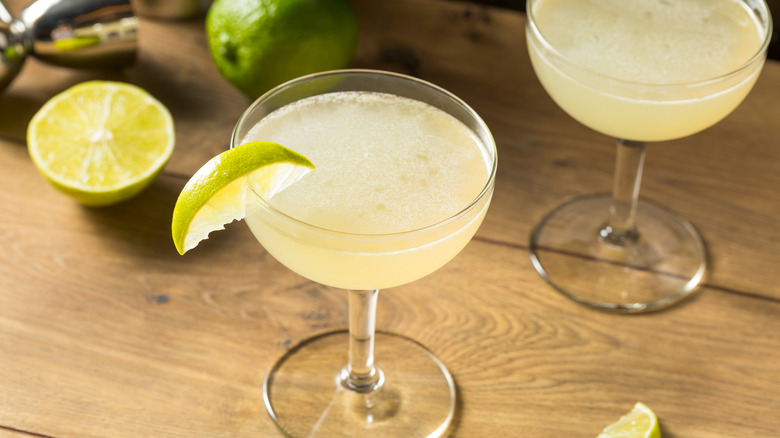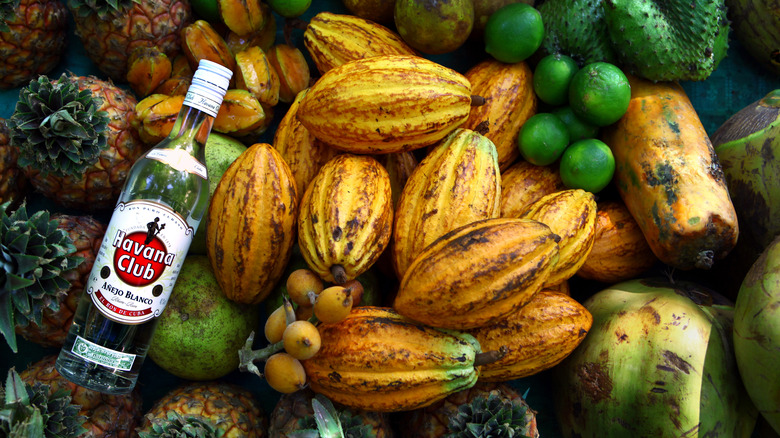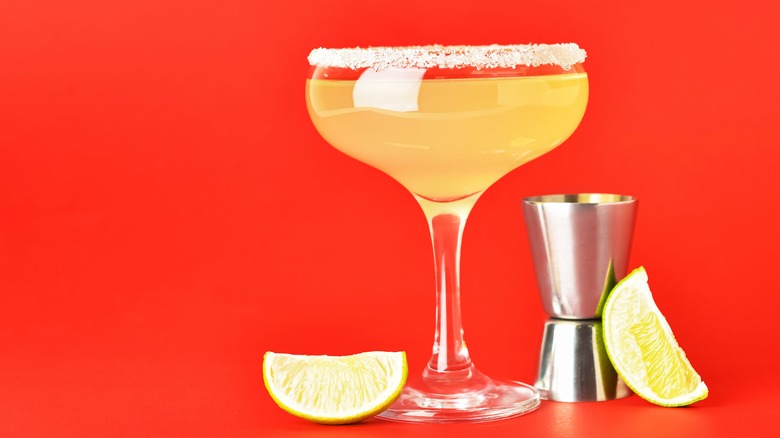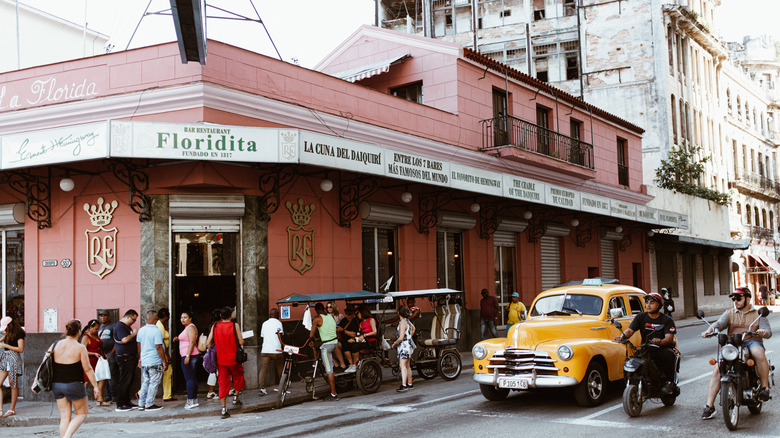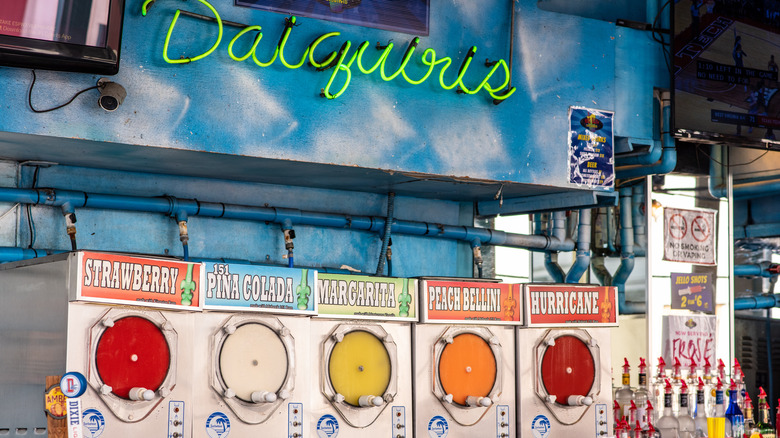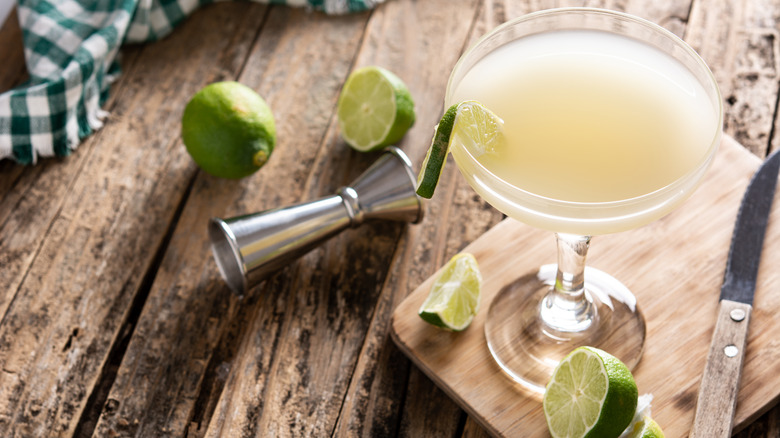The History Of How The Classic Daiquiri Cocktail Got Its Name
On an evening in the 1890s, near the port town of Daiquirí, Cuba, the American engineer Jennings Stockton Cox is throwing a party. As Cox attempts to refill his guests' glasses, he realizes that he has run out of gin. To keep the party going, he uses what's available: rum (via Caroline Pardilla, writing for Eater). To make sure the drink goes down easily, he throws in a bit of lime and brown sugar. The drink is a hit, and the daiquiri is born. So the story goes, according to Cox's granddaughter, Cocktailsforyou reports.
What we know for sure is that in 1896, Cox wrote down the first documented recipe for the daiquiri on a card and signed it, Pardilla says. Cox wrote the recipe for six people: "Juice of six lemons, 6 teaspoons of sugar, 6 Bacardi cups of 'Carta Blanca,' 2 small cups of mineral water, plenty of crushed ice. Shake well" (per Cocktailsforyou).
The drink's origins most likely date back much further, with links to the British Royal Navy's scurvy-preventing "grog" (sugar, lime juice, rum, and water) and even el draque, said to be the world's first cocktail, invented by Sir Francis Drake in the 1500s (rum, lime, sugar). Much like its complex origin story, the daiquiri flits between prestige and camp, winning the love of authors and presidents, while also a staple of all-inclusive resorts and drive-thru bars.
A more complicated origin story
Since the cocktail's three main ingredients—rum, lime, and sugar—are abundant in Cuba, it's likely Cox merely documented what many had already been drinking for some time, (per Eater). Daiquirí, an indigenous Taíno word (per Vice), is a small town near the Bacardí Rum Distillery, surrounded by sugar cane fields, and located on the southeastern tip of Cuba, roughly 14 miles east of Santiago de Cuba, describes The Flavier Times.
Another prevailing theory is that Cox took his time testing and developing the concoction. Cox was a part of a great influx of American businessmen and engineers who came to Cuba after the Spanish-American War. It is said that Cox secured a Bacardí ration for the Daiquirí ironworkers, and perhaps used some of the supplies and other local ingredients for his experiments (per Cocktailsforyou).
Emily Ramirez Hernandez of GoNOLA suggests that the drink Cox penned was popular among many engineers in the area. Its origins are even muddier, cocktail historian Liz Williams explains to Hernandez, calling the drink a "social invention" with unclear origins, suggesting that perhaps locals introduced the Americans to the drink. Will Shenton of Bevvy goes further, calling it absurd to credit an American emigrant with inventing the cocktail, positing that locals had probably been drinking something similar for possibly centuries.
The daiquiri goes stateside
The daiquiri remained in Cuba until 1909, when the USS Minnesota arrived. The ship's captain, Charles H. Harlows, and medical officer Lucius W. Johnson visited famous sites of the Spanish-American War (per Cocktailsforyou). Daiquirí, the landing site of Roosevelt and his Rough Riders, made it onto their itinerary (per Bevvy).
During their visit, Cox himself served the pair his concoction. Later, Johnson recalled the moment to the Baltimore Sun: "He mixed in each glass a jigger of rum, the juice of half a lime, and a teaspoonful of sugar....In that hot, humid weather the ice melted rapidly and the glass quickly became frosted. We were delighted with the drink" (per Cocktailsforyou).
Johnson was so delighted that he brought the recipe back to Washington D.C. and shared it with the Army and Navy Club, a military social club for military officers (via Army and Navy Club). Today, the club is home to the Daiquiri Lounge, where traditionally, members drink the beverage in front of the painting of "Santiago Bay" to honor the historic battle site, reports Cocktailsforyou.
Others link the drink's migration north to U.S. Congressman William Chanler, who purchased mines near Santiago and brought the recipe back to New York, per Hamilton Beach. One How To theorizes that many others involved in the mining industry could have returned home with the drink recipe in hand. The daiquiri's popularity slowly grew in both the mid-Atlantic and in Cuba, with Prohibition helping increase the drink's allure.
Papa Hemingway adopts the daiquiri
The blender's invention gave rise to a new era for the daiquiri, while simultaneously solidifying the cocktail's place in literary history. Constantino "Constante" Ribalaigua Vert, owner of the Havana bar Floridita, used the electric blender to add shaved ice to the drink, creating the frozen daiquiri (per Eater). Vert, known as "The Cocktail King of Cuba," invented over 200 unique drinks and modified many others in addition to the daiquiri (via GoNOLA).
One day, Ernest Hemingway, a resident of Havana, walked into Floridita. Some say that he was looking for the bathroom (per Wine Enthusiast). After trying Vert's version of the drink Hemingway said: "That's good, but I'd prefer it without the sugar ... and double the rum" (via Wine Enthusiast). From that day forward, Hemingway became a Floridita regular, reportedly drinking 15 daiquiris in one night, writes Pardilla at Eater. It's no coincidence that around the same time F. Scott Fitzgerald, friend of "Papa" Hemingway, would mention the daiquiri in his novel "This Side of Paradise."
In one of Vert's famous modifications, he transformed the daiquiri into the "Papa Doble," in honor of the author (per GoNOLA). For the Papa, the cocktail has twice the rum and maraschino liquor instead of sugar (Wine Enthusiast). In his book "Islands in the Stream," Hemingway writes, "This frozen daiquiri, so well beaten as it is, looks like the sea where the wave falls away from the bow of a ship when she is doing thirty knots" (via Chilled).
The poolside slushy
Excepting Hemingway's blended version, the daiquiri is a classic three-ingredient drink, similar to a gimlet or a margarita, explains Katie Brown of Vinepair. Cox's original version is a simple sour: a base spirit, citrus, and a sweetener (via Chilled). So how did this simple cocktail turn into the fruity poolside slushy we know today?
Shannon Mustipher, a spirits educator, explains to Brown that "In the '50s and '60s, convenience foods were very popular. Products like that were very amenable to mass-produced everything, including daiquiris you would put in a machine." Perpetuated by all-inclusive resorts, the drink developed into the slushy-machine version represented in the likes of Red Lobster's Berry Mango Daiquiri, described on the menu as "a fruit smoothie with a rum boost," reports Brown.
Ramone Martinez of New Orleans's daiquiri scene describes the drink in Where Y'at: "Most of the daiquiris you see around here are a one-gallon syrup — a concentrate, that they add to four gallons of water. ... Then they add two bottles of whatever liquor they've chosen for that mix. "
A far cry from drink beloved in the mines in southern Cuba, the icy and easy-to-make beverages are good business in New Orleans, explains Martinez. Some daiquiri shops can bring in up to $50,000 in one day, Where Y'at reports, continuing to say that the slushy-style daiquiris, made for drinking in the streets and accompanied by colorful souvenir cups, have become a key part of New Orleans culture and a point of pride.
Daiquiri time out
With the rise of craft cocktail culture and a newfound interest in cocktail history, the classic daiquiri is also making a comeback, as Pardilla writes for Eater. And not only that, it's getting a new Cocktail King-style twist. This time, the daiquiri re-inventors are Boston-based.
As with all things daiquiri-related, this new version has a unique origin story. Creator Andrew Dietz says that he and his bartender friends were in Martha's Vineyard talking about someone they knew, whose actions they didn't approve of. The group came to the conclusion that the person would have behaved better had they had a daiquiri first, according to Drew Starr, writing for Eater Boston. Thus began the Daiquiri Time Out, or DTO. DTO may also refer to a scene in the 2005 film "Wedding Crashers" in which Christopher Walken's character requests a "daiquiri time out" during a game of touch football, Pardilla suggests.
Rather than a cocktail, the DTO is a shot its creators say is to be enjoyed after a stressful moment or when you need a pause. Starr describes the drink as a ritual that encourages people to put their problems aside. Pardilla says this new mini version of the drink has become the new bartender's handshake, unseating previous drinks served between fellow industry insiders.
The daiquiri's association with soothing tension as well as celebration has historic precedent. Per ABCF News, the daiquiri was John F. Kennedy's go-to drink, imbibed with his wife, Jackie, in celebration after his presidential election victory in 1960.
